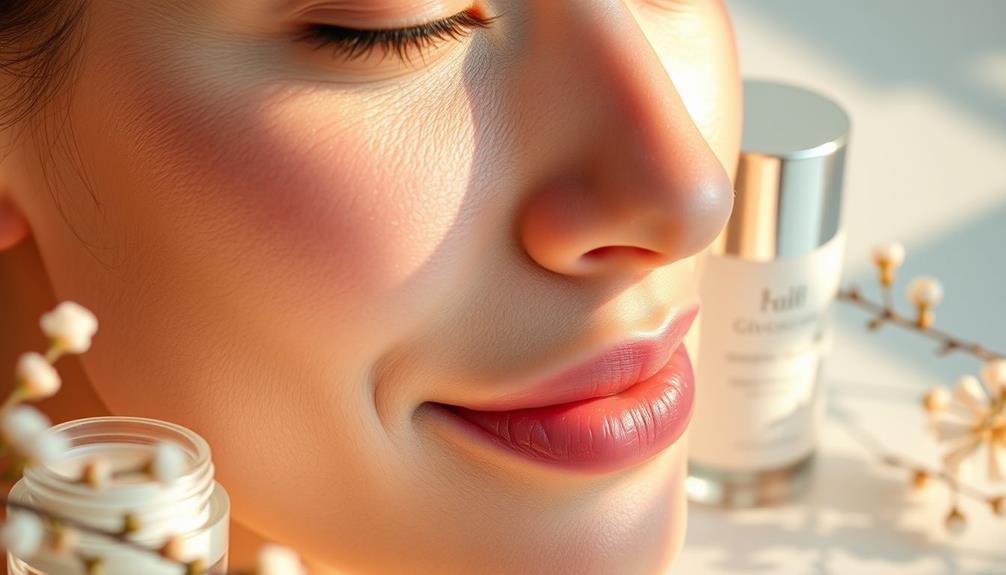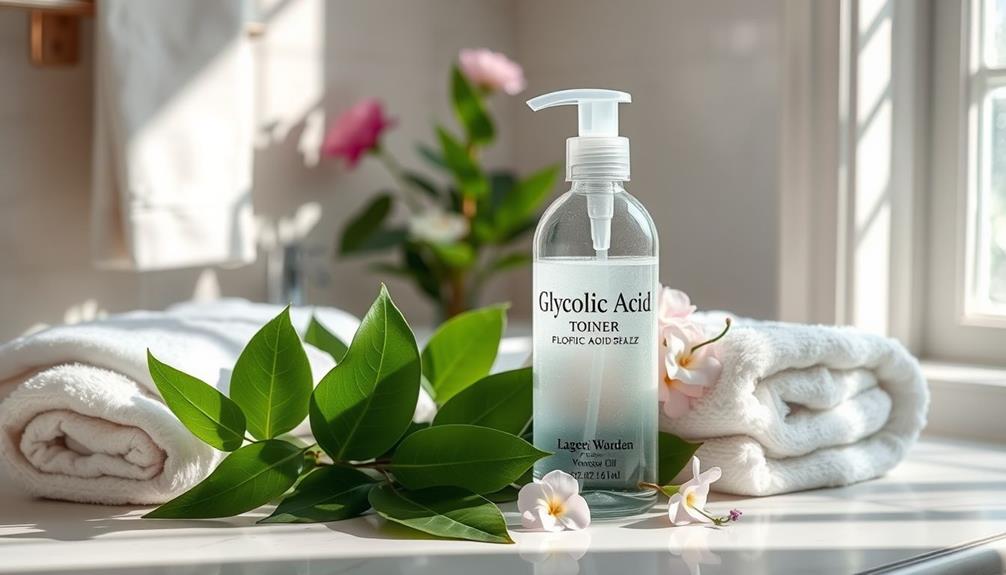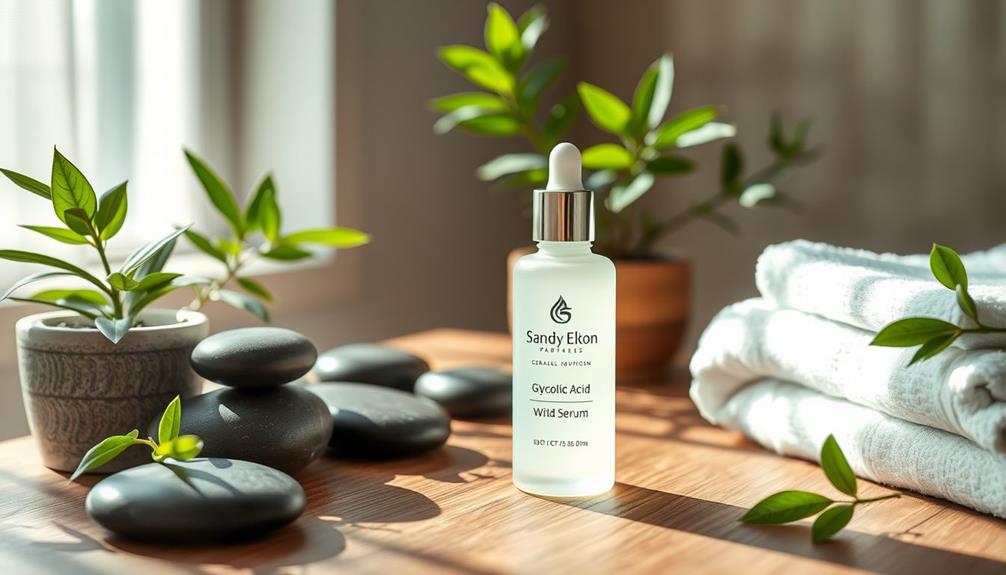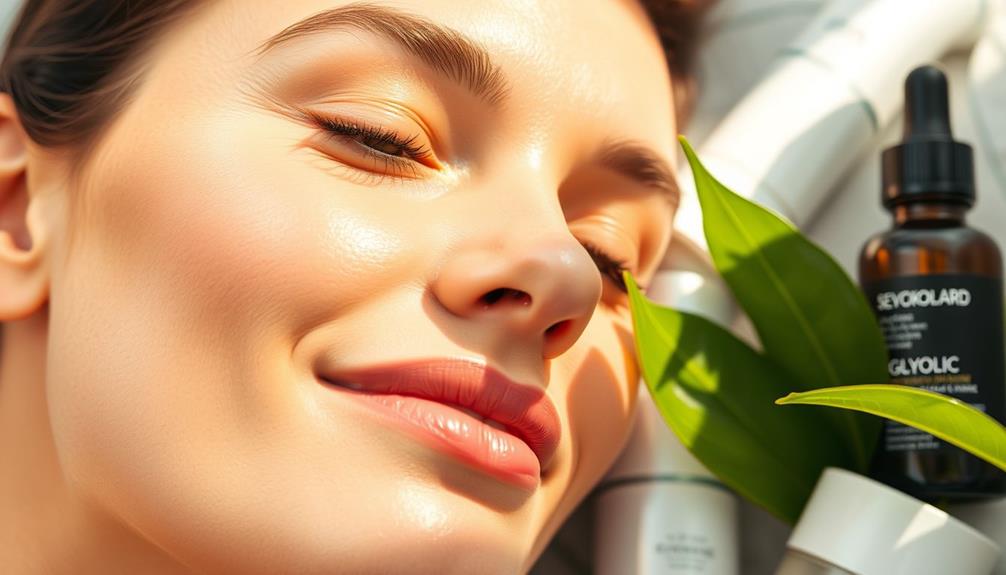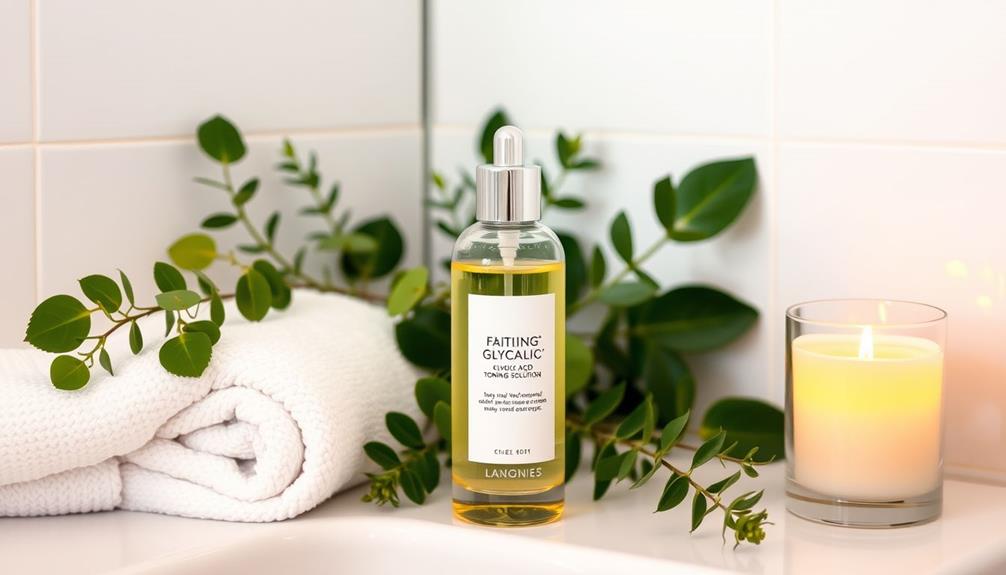Glycolic acid cream is your secret weapon for a smooth, radiant face. This powerful exfoliant penetrates deeply to remove dead skin cells, revealing a brighter complexion while reducing fine lines and dark spots. It promotes cell renewal, improves skin texture, and helps clear acne breakouts. For the best results, start with a lower concentration and gradually increase usage, ensuring you always follow up with sunscreen, as it can increase sun sensitivity. Stick with it for long-term benefits like minimized pores and enhanced skin clarity. Keep going to discover the best tips and products for your perfect skincare routine!
Key Takeaways
- Glycolic acid promotes exfoliation, removing dead skin cells for a smoother, brighter complexion.
- Regular use reduces fine lines, wrinkles, and dark spots, enhancing overall skin radiance.
- It stimulates collagen production, improving skin texture and promoting a youthful appearance.
- Glycolic acid enhances absorption of other skincare products, maximizing their effectiveness in your routine.
What Is Glycolic Acid?

Glycolic acid, a powerful exfoliant derived from sugar cane, helps rejuvenate your skin by promoting cell turnover and enhancing its overall texture.
As a water-soluble alpha hydroxy acid (AHA), glycolic acid features the smallest molecular size among its peers, allowing it to penetrate deeper into your skin. This unique property makes it a highly effective chemical exfoliant.
In addition to its exfoliating benefits, incorporating essential oils, such as lavender oil for relaxation, can further enhance your skincare routine by promoting overall well-being.
When you apply glycolic acid, it works by loosening and removing dead skin cells from the surface. This process not only reveals a brighter complexion but also improves your skin texture over time.
With consistent use, you'll notice a reduction in fine lines and wrinkles, along with diminished dark spots and hyperpigmentation.
Glycolic acid is commonly found in a variety of skincare products, including cleansers, toners, serums, and peels.
Incorporating these products into your routine can provide targeted treatment for various skin concerns. Whether you're looking to enhance your overall glow or tackle specific issues, glycolic acid's exfoliating properties make it a go-to ingredient for achieving smoother, healthier skin.
Benefits of Glycolic Acid Cream

Using glycolic acid cream can transform your skin by promoting exfoliation and enhancing cell renewal.
This process can be further supported by confirming that your indoor air quality is ideal, as air purifiers improve indoor air quality considerably by reducing allergens and harmful particles.
You'll notice a reduction in acne and dark spots, leading to a clearer and more even complexion.
Plus, its hydrating properties guarantee your skin stays moisturized while reaping these benefits.
Exfoliation and Skin Renewal
How can glycolic acid cream transform your skin? This powerful exfoliant promotes cell turnover, revealing a smoother and more radiant complexion. By breaking down the bonds between dead skin cells, glycolic acid accelerates the natural exfoliation process, leading to a rejuvenated appearance.
Additionally, incorporating antioxidants like those found in rooibos tea can further enhance your skin's health and combat oxidative stress. Here are some benefits you'll enjoy:
- Smoother skin: Regular use helps reduce the appearance of fine lines and wrinkles, giving you a youthful glow.
- Even skin tone: It fades dark spots and hyperpigmentation, resulting in a more uniform skin tone over time.
Incorporating glycolic acid cream into your routine can work wonders for your skin's overall health. As it stimulates collagen production in the deeper layers, you'll notice not just a change in texture but also a brighter, more radiant complexion.
With consistent use, you're on your way to achieving that smooth, even skin tone you've always desired. Don't underestimate the power of exfoliation—glycolic acid could be the secret weapon in your skincare arsenal.
Acne and Hyperpigmentation Treatment
For anyone struggling with acne and hyperpigmentation, incorporating glycolic acid cream into your skincare routine can offer transformative results. This powerful ingredient effectively exfoliates your skin, removing dead skin cells that clog pores and contribute to breakouts. As a result, you'll experience fewer acne flare-ups and clearer skin.
Additionally, maintaining a healthy skincare regimen is essential for overall skin health, just as regular exercise is necessary for keeping your dogs active and healthy dog health and nutrition tips.
Glycolic acid also promotes cell turnover and stimulates collagen production, which is vital for fading hyperpigmentation like dark spots and uneven skin tone caused by sun exposure or acne scarring. With regular use, you'll notice an improvement in skin texture and clarity, making it an ideal choice for those with acne-prone or dull skin.
Moreover, glycolic acid enhances the absorption of other active ingredients in your skincare routine, allowing them to work more effectively. Clinical studies support its efficacy, showing significant reductions in both acne lesions and hyperpigmentation over time.
How to Use Glycolic Acid Cream
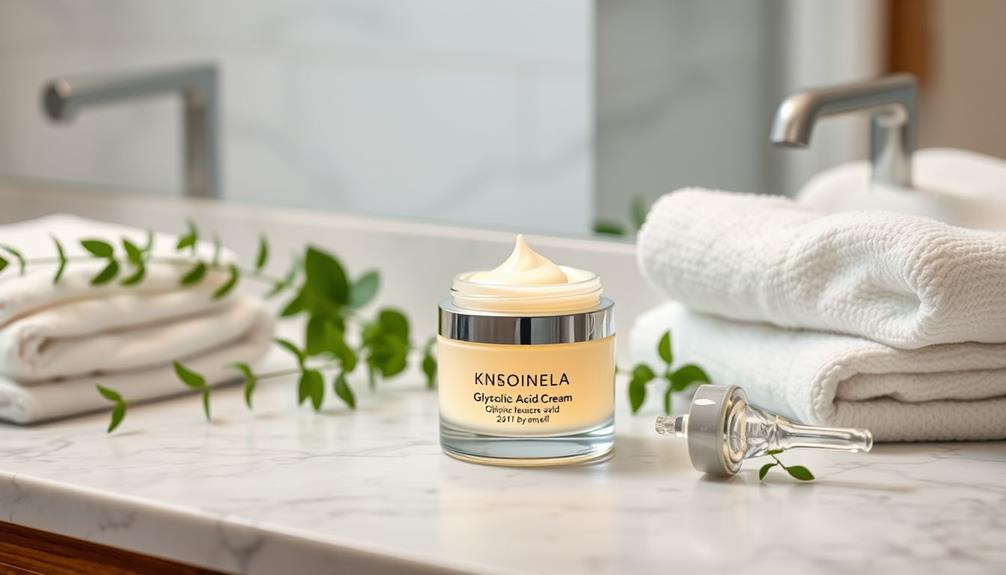
Cleansing your face thoroughly is essential before applying glycolic acid cream to guarantee maximum effectiveness. This first step removes any makeup or impurities that could hinder the cream's performance.
Here's how to use glycolic acid effectively:
- Start with a lower percentage: Use a cream with a concentration of 5-10% to minimize irritation, especially if you have sensitive skin.
- Conduct a patch test: Before applying the cream to your entire face, perform a patch test on a small area to check how your skin tolerates it. This is vital for avoiding adverse reactions.
Application Methods
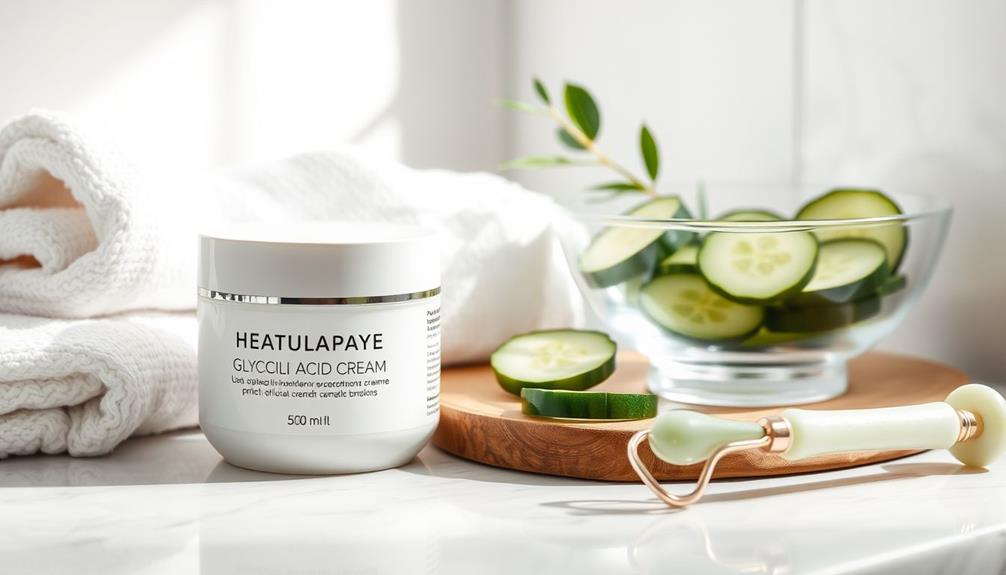
When applying glycolic acid cream, it's important to take into account the products you use beforehand.
Cleansers and toners can enhance the effectiveness of glycolic acid, while serums and moisturizers play an essential role in your skincare routine.
Let's explore how these elements work together for the best results.
Cleansers and Toners
Incorporating glycolic acid cleansers and toners into your skincare routine elevates exfoliation and enhances skin texture effectively. Glycolic acid cleansers usually feature lower concentrations of the acid (around 5-10%), making them perfect for gently introducing your skin to exfoliation without causing irritation.
For example, the GlyPro AHA Resurfacing Cleanser contains 10% glycolic acid along with soothing ingredients like aloe vera and green tea extract, minimizing skin sensitivity while cleansing.
Using a glycolic acid toner can refine your pores and prep your skin for further treatments. Regular use of these products can lead to a noticeably brighter complexion by removing dead skin cells that contribute to dullness and breakouts.
Here are some key benefits to keep in mind:
- Enhanced exfoliation: Gently removes dead skin cells.
- Brighter complexion: Promotes a more radiant appearance.
As you enjoy your new routine, remember to apply sunscreen daily, as glycolic acid can increase your skin's sensitivity to sunlight. This simple step will help keep your skin healthy and radiant.
Serums and Moisturizers
After you've cleansed and toned your skin, applying glycolic acid serums and moisturizers effectively targets specific concerns while enhancing overall skin texture. Serums deliver concentrated exfoliating benefits, making them ideal for treating fine lines and uneven skin tone. Follow this with a glycolic acid moisturizer to maintain hydration and further improve your skin's texture.
Here's a simple guide to help you apply these products effectively:
| Step | Product Type | Key Benefits |
|---|---|---|
| 1. Cleanse | Cleanser | Removes dirt and impurities |
| 2. Tone | Toner | Prepares skin for treatment |
| 3. Apply | Serum | Targets fine lines and hyperpigmentation |
| 4. Moisturize | Moisturizer | Locks in hydration and enhances texture |
To maximize efficacy, apply serums after cleansing and before moisturizers. Start with lower concentrations of glycolic acid, especially if you have sensitive skin, and gradually increase as your skin tolerates it. With regular use, you'll notice smoother, brighter skin and improved clarity over time.
Ideal Skin Types for Glycolic Acid
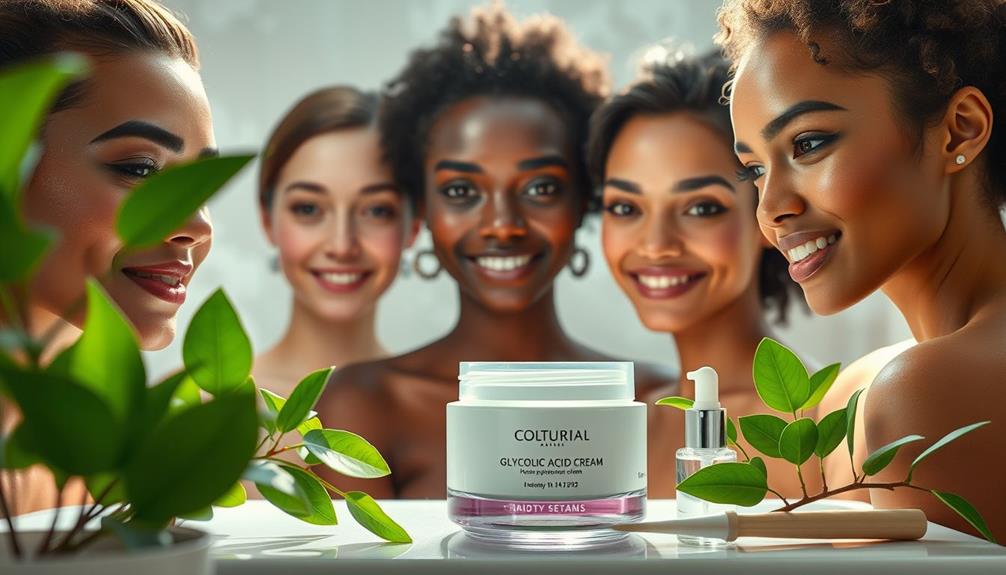
Glycolic acid is a versatile ingredient that works wonders for various skin types, especially oily and acne-prone skin. Its exfoliating properties help unclog pores and reduce breakouts, making it a go-to option for those struggling with these issues. If you have normal skin, you'll appreciate how glycolic acid enhances texture and promotes a brighter complexion.
However, if you have dry or sensitive skin, it's essential to be cautious. Here are some tips for using glycolic acid effectively:
- Start with lower concentrations (under 10%) to minimize irritation.
- Use it less frequently until your skin adjusts.
For individuals dealing with signs of aging, glycolic acid can help improve skin tone and texture, making it a great addition to your routine. Just remember, if you have conditions like rosacea or eczema, consulting a dermatologist is a must to avoid exacerbating any existing issues.
Potential Side Effects

While glycolic acid offers numerous benefits, it's important to be aware of potential side effects that can arise during use. Initially, you might notice redness and irritation, which typically subsides within a few days. Don't be alarmed if you experience peeling or flaking skin; this is often a sign of effective exfoliation, especially with higher concentrations of glycolic acid.
| Side Effect | Description |
|---|---|
| Redness & Irritation | Common during initial use, usually temporary. |
| Peeling | Sign of effective exfoliation, especially at high concentrations. |
| Increased Sensitivity | Skin may become more sensitive to sunlight; use sunscreen with SPF 50 or higher. |
Additionally, you might encounter dryness around sensitive areas, like your nose. This can be managed with proper moisturization after applying glycolic acid. If you experience severe reactions, such as intense irritation or any allergic responses, stop using the product immediately and consult a dermatologist for the best course of action. Being informed can help you enjoy the benefits of glycolic acid while minimizing any discomfort.
Recommended Products
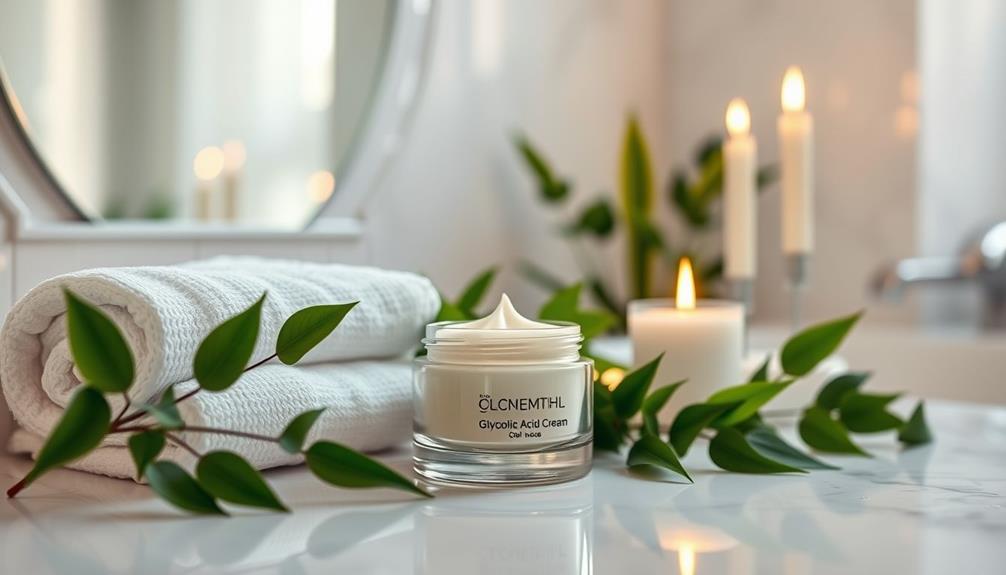
When exploring glycolic acid options, several recommended products cater to different skin types and needs.
These glycolic acid-based creams can enhance your skincare routine, helping to improve skin texture and reduce the appearance of fine lines.
Here are three dermatologist-recommended products you might consider:
- Sesderma Acglicolic Classic Forte: With a high concentration of 10% glycolic acid, it's perfect for those wanting significant exfoliation and skin rejuvenation.
- Glycolic Acid 6 Cream: An intermediate option with 6% glycolic acid, ideal for users wanting to progress in their glycolic acid use while managing sensitivity.
Incorporating these products into your routine can lead to remarkable improvements in your skin's radiance and texture.
Whether you're dealing with fine lines or uneven tone, choosing the right glycolic acid product is essential for achieving your skincare goals.
Always consult with a dermatologist to find the best fit for your unique skin needs.
Expert Skincare Tips
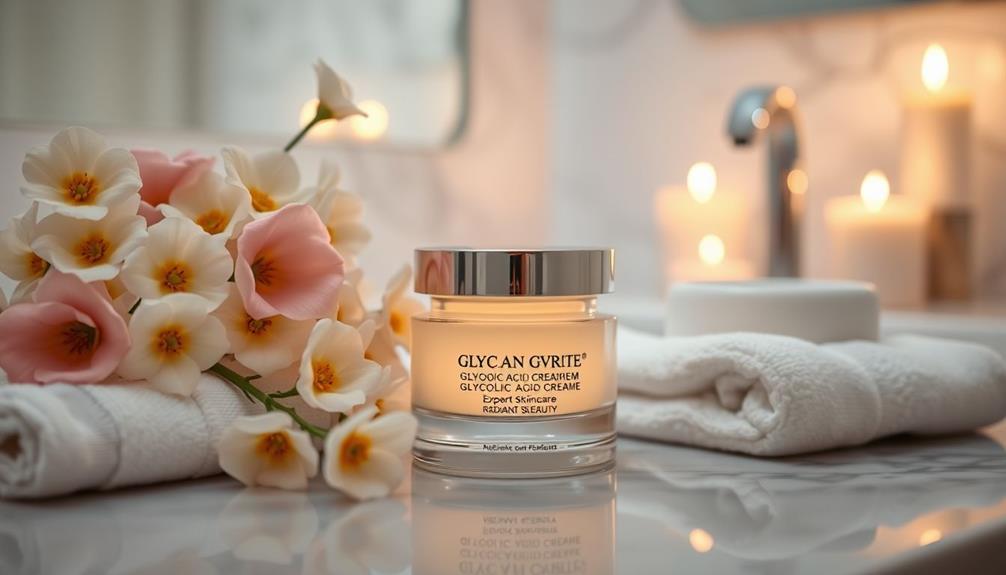
To achieve the best results with glycolic acid cream, incorporate it into your nighttime routine for ideal skin texture and cell turnover.
Start with a lower concentration of glycolic acid, around 5-10%, applying it two to three times a week. This gradual increase helps you monitor your skin tolerance and avoid irritation. Always perform a patch test before full application, especially if you have sensitive skin or are new to chemical exfoliants.
Be mindful that glycolic acid can increase your skin's sensitivity to UV rays. As a result, it's essential to pair its use with a broad-spectrum sunscreen during the day to protect against photoaging.
To further enhance your routine and combat potential dryness, consider combining glycolic acid cream with hydrating ingredients like hyaluronic acid. This combination won't only address skin concerns but also help maintain overall hydration.
Long-Term Results

Consistent use of glycolic acid cream transforms your skin over time, delivering smoother texture and reduced fine lines. As you incorporate this powerhouse ingredient into your routine, you'll notice significant long-term benefits that enhance your skin's overall health and appearance.
Here's what you can expect:
- Smoother skin texture: Glycolic acid stimulates collagen production, helping to minimize fine lines and wrinkles.
- Fading dark spots: Regular application evens out your skin tone and reduces hyperpigmentation.
With long-term use, glycolic acid cream not only refines your skin texture but also keeps your complexion clear by minimizing pore size.
You'll enjoy fewer acne breakouts and better absorption of other skincare products, making them more effective. This means that your serums and moisturizers will work harder for you, leading to a more radiant and youthful appearance.
Stick with it, and you'll reap the rewards of consistent glycolic acid application, transforming your skin's look and feel over time.
Conclusion
Incorporating glycolic acid cream into your skincare routine can truly elevate your complexion, revealing a smooth and radiant face reminiscent of the elegance of a bygone era.
By understanding its benefits and following the right application methods, you'll discover the secret to youthful skin.
Just remember to listen to your skin and adjust usage accordingly.
With consistent care, you'll enjoy long-term results that make you feel like you've just stepped out of a classic film.
